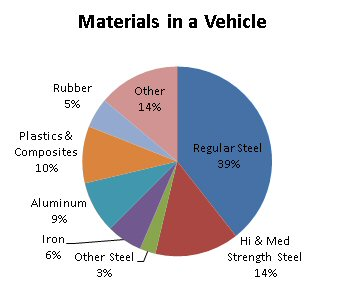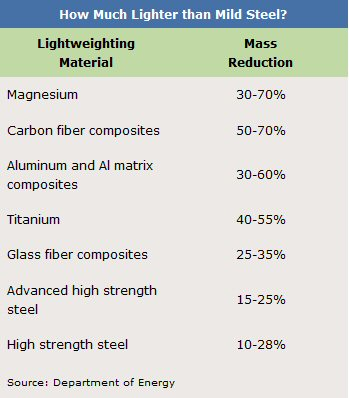

To meet proposed US federal fuel-efficiency standards – 54.5 miles per gallon by 2025 (nearly double today’s standard) – the automotive industry is reducing the weight of its vehicles, largely by substituting lighter weight materials and through vehicle redesign.
For example, carbon fibre composites offer a 50-70% mass reduction over mild steel (the most used material in vehicles), and glass fibre composites a 25-35% reduction (see table).
A 10% reduction in mass translates into estimated fuel savings of 6-7%, explains NIST.
To reach the 2025 standard, car makers are aiming to cut from a few hundred pounds to upwards of half a ton off the weight of domestic light vehicles, now averaging almost 4000 lbs.
| The better you understand the materials that you use, the better the design of the car and, ultimately, the better the car you build. |
| Tim Foecke, Director, NCAL |
The NCAL specialises in measuring how new lightweighting materials are strained in response to the stresses of forming operations that shape the materials into hoods, fenders, door panels, floor pans and other parts. It also studies how the materials will hold up in collisions, which is strongly influenced by material type and part shape.
Every gram counts
Car companies aim to exploit every cost-effective opportunity to reduce weight and, with it, fuel consumption. So that auto makers are beginning to “manage by the gram,” according to one industry source.
“We are lightweighting every aspect – body, chassis, interior and powertrain,” says Cedric Xia, materials scientist at Ford’s Research & Innovation Center.
In particular, “lightweight materials are important for reducing the mass of the body of the vehicle, which opens the way to other weight-saving strategies,” he explains.
Lighter bodies, he adds, mean that car manufacturers can downsize other parts of vehicles, from batteries, engines and transmissions to brakes and tyres.
Unfortunately, the new materials options rarely behave predictably and are more complex in chemical composition and internal structure than mild steel, the auto industry’s material of choice for about a century.
“There can be lots of problems,” says Xia, who ranks difficulties in controlling dimensional accuracy at the top.
And if the materials don’t behave as desired, manufacturing costs can soar, hiking the final price of vehicles.
The NCAL aims to address this issue by delivering reliable materials data, improved measurement capabilities, test methods and better understanding of the underlying mechanisms at work as a particular material is stressed – during manufacturing or a collision. NCAL partners include car companies, steel, aluminium and polymer composite suppliers, national laboratories, and universities.
Collaboration is essential
“The auto industry is working with a sense of urgency. Collaboration is essential,” says Tim Foecke, Director of NCAL.
“Companies don’t have the time to solve the problem multiple times by working on their own. They’ve come together to meet this shared challenge. With our partners, we want to help them tackle it and solve the problem so they can move on to compete.”
NIST is an agency of the US Department of Commerce.


